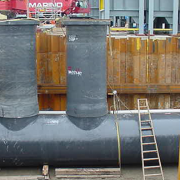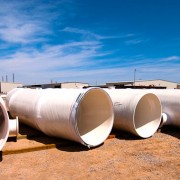The Large Diameter Composite Pipe Market Continues to Grow
Fiber reinforced polymer (FRP) is our passion here at Beetle, which is why we were very pleased to see a recent article published by Reinforced Plastics.com. “Large diameter composite pipe is gaining market share at the expense of pipe made with commodity materials, in general-purpose as well as specialty applications, ” Ben E Bogner in the article “Large Diameter Composite Pipe: Lasting Function in a World of Growth.” It’s no secret that FRP pipe isn’t the most glamorous of FRP applications, but functionality and durability have allowed the large diameter composite pipe industry to gain in strength as pipe made with iron and concrete lose market shares.
When we talk about large diameter pipe, we’re generally referring to, “pipe that is at least 12 inch in diameter. At the higher end, the sector includes composite pipe in diameters as large as 14 feet.” This sort of pipe is generally used for a number of applications, but the most common, according to the article, are:
- drinking water projects such as raw water supply lines for potable water systems;
- irrigation systems for agriculture;
- feed lines and penstock for hydroelectric power plants;
- circulation for cooling water systems, primarily for power plants;
- sanitary sewer projects for pressure as well as gravity sewer systems, and
- pipeline rehabilitation as ‘slip liners.’
There are a number of features that have contributed to the increased market share controlled by composite large pipes. One of the most attractive features of FRP pipe is that is it resistant to corrosion, even the corrosion you see with sulphuric acid. Composites are also a cost effective alternative to other kinds of raw materials like pig iron and steel. Even though all kinds of raw materials costs have been steadily creeping upward, the cost of composites hasn’t increased nearly as much.
“Another reason for the increased market share is the fact that FRP pipes for the last 30 years have proven to be a reliable alternative. More than 60 000 km (37 280 miles) of composite large diameter pipe are in operation worldwide to prove that the material will perform long-term as predicted.”
To read the full article, click here.













